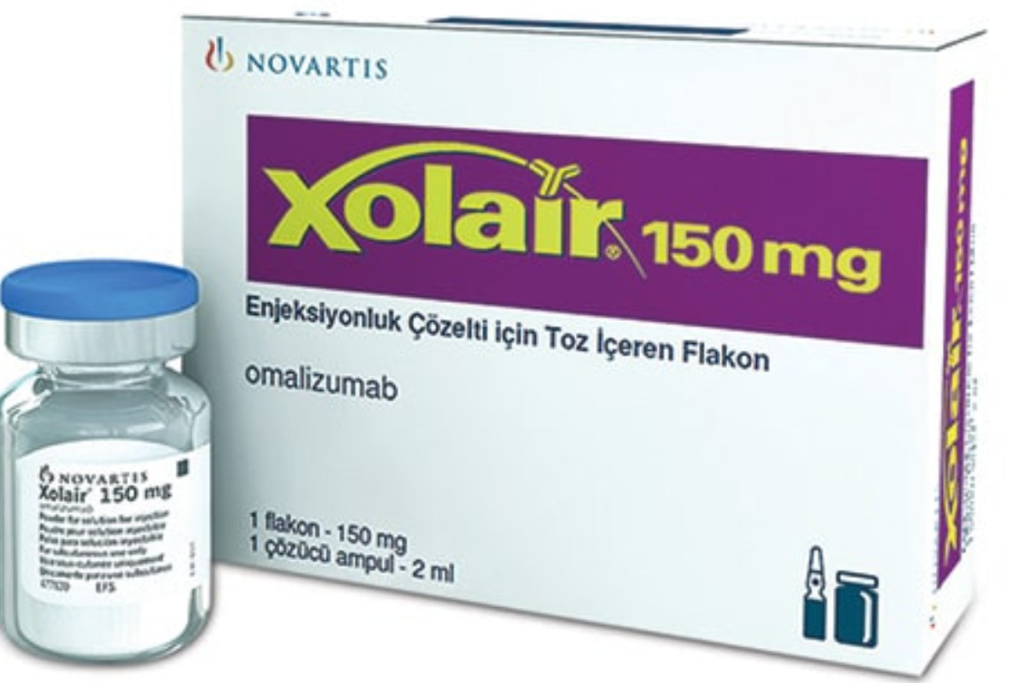Last Updated on October 20, 2025 by Batuhan Temel
Xolair, also known as omalizumab, is a new kind of medicine. It has changed how we treat allergies. It helps with asthma, chronic urticaria, and food allergies.

The FDA has approved Xolair for people aged 6 and up with severe asthma. It also helps those with chronic urticaria aged 12 and older who don’t get better with antihistamines. Now, it’s used to prevent allergic reactions in food allergy patients, too.
Omalizumab, known as Xolair, is a big step forward in allergy treatment. It brings new hope to those with severe allergies. Let’s explore what Xolair is, its history, and its impact on allergies.
Xolair, or omalizumab, is a recombinant DNA-derived humanized monoclonal antibody. It targets human immunoglobulin E (IgE). By doing so, it lowers the amount of free IgE in the blood.
This action helps reduce allergic reactions. Xolair is used to treat severe asthma, chronic urticaria, and chronic rhinosinusitis with nasal polyps.
The story of Xolair’s creation is linked to understanding IgE’s role in allergies. It was first approved for asthma in 2003. Over time, it was approved for other allergies too.
“The development of Xolair has been a pivotal moment in treating allergies,” it’s said. It offers a new option for those who don’t get better with usual treatments.

Xolair is more than a medicine; it’s a big leap in fighting allergies. Its growth and approval for different conditions show its key role in allergy treatment today.
Xolair is a smart way to handle allergic reactions. It’s a special medicine made from DNA that targets IgE, a main cause of allergies.
Xolair works by binding to IgE. This action reduces the amount of IgE that can cause allergies. It stops IgE from reacting with mast cells and basophils, which are important in allergic reactions.
This process has several important effects:
IgE antibodies are key in starting allergic reactions. Xolair targets these antibodies, reducing the allergic response. This leads to fewer symptoms in conditions like asthma and chronic spontaneous urticaria.
The benefits of Xolair’s action include:
Understanding how Xolair works shows its importance in managing allergies. It has the power to greatly improve patient outcomes.
Xolair is a key treatment for those with moderate to severe persistent asthma. It’s great for people whose symptoms don’t improve with inhaled corticosteroids.
To get Xolair, you must have asthma that’s not well-controlled. You also need to have allergies, which are confirmed through tests. Symptoms should not be managed with inhaled corticosteroids alone.
Xolair is very effective for those who qualify. It works by lowering IgE antibodies, which helps reduce asthma attacks. This makes life better for patients, with fewer emergency visits.
Studies show Xolair cuts down on asthma symptoms and boosts lung function. It also means fewer daytime and nighttime symptoms and less need for rescue meds.
Xolair is okay for kids aged 6 and up with severe asthma. The dosage is based on weight, just like for adults. Clinical trials have shown it’s safe and works well for kids.

Managing asthma in kids is tough. Xolair offers hope for families wanting to control their child’s symptoms. It helps kids have fewer asthma attacks, leading to more active lives.
Chronic spontaneous urticaria (CSU) is tough to manage, but Xolair helps many patients. It’s marked by recurring wheals and angioedema without a clear cause. This affects patients’ lives a lot.
Antihistamines are often the first treatment for CSU. But some patients don’t get better with them.
When antihistamines don’t work, Xolair (omalizumab) is a good choice. Xolair is approved for patients 12 and older with CSU who don’t get better with antihistamines. It targets IgE antibodies, key in allergic reactions and urticaria symptoms.
“Xolair has changed how we treat CSU,” say doctors. It brings hope to those who didn’t find relief with usual treatments.
Xolair is given 300 mg every 4 weeks by injection. This simple dosing helps patients stick to their treatment plan.
Studies show Xolair cuts down CSU symptoms. This makes life better for these patients. They see fewer wheals and less itching.
Xolair meets a big medical need for CSU patients. It brings relief and better lives to people all over the world.
Xolair is a key treatment for adults with chronic rhinosinusitis with nasal polyps (CRSwNP). This condition makes life hard, causing nasal blockage, loss of smell, and facial pain.
For those who don’t get better with nasal corticosteroids, Xolair is a good alternative. It works by lowering IgE antibodies, which are key to inflammation of CRSwNP.
Adults get regular Xolair injections. How often depends on their health and how they react to the treatment. Studies show it greatly improves symptoms and life quality for CRSwNP patients.
Xolair is great for those who didn’t do well with corticosteroids. It offers a new way to manage symptoms and improve well-being. Clinical trials show it reduces nasal polyp size and improves smell.
As we learn more about CRSwNP, treatments like Xolair are making a big difference. Its innovative method and proven results make Xolair a valuable option for adults with this tough condition.
Food allergy management is changing with Xolair’s approval. It helps reduce the risk of allergic reactions, including anaphylaxis, in patients with IgE-mediated food allergies. This is a big step forward in treating severe food allergies, bringing hope to patients and healthcare providers.
Xolair is effective in lowering the risk of allergic reactions in patients with IgE-mediated food allergies. It works by binding to IgE antibodies, stopping the allergic reaction that can lead to severe reactions like anaphylaxis. This makes Xolair a valuable treatment for patients at risk of life-threatening allergic reactions.
Key Benefits:
Xolair is approved for patients aged 1 year and older with IgE-mediated food allergies. This wide age range makes Xolair a versatile treatment, suitable for both kids and adults. Treating younger patients is key, as it meets a critical need for effective food allergy management in children.
Treating food allergies in young children requires careful consideration and a tailored approach. Xolair’s approval for patients as young as 1 year old shows its promise in making a big difference in the lives of families with severe food allergies.
While Xolair is a big step forward in food allergy treatment, it should be used with allergen avoidance strategies. Patients and caregivers must avoid known allergens. Xolair is not a replacement for avoiding allergens but a treatment that reduces the risk of reactions from accidental exposure.
Effective food allergy management involves:
By using Xolair with established allergen avoidance strategies, patients can manage their food allergies better. This approach reduces the risk of severe reactions and improves their quality of life.
Xolair is given through subcutaneous injections. These are usually every 2 or 4 weeks, based on the patient’s needs. This method is key for managing severe allergies like asthma and chronic spontaneous urticaria.
The injection process involves giving Xolair under the skin. It can be done in a healthcare setting or at home with the right training. The frequency of injections depends on the patient’s condition and how well they respond to treatment.
Healthcare providers are important for teaching patients how to get Xolair injections right. They guide on rotating injection sites, using the prefilled syringe or autoinjector, and watching for any bad reactions.
While Xolair injections can be given at home, many prefer or need the first ones in a healthcare setting. This lets healthcare professionals watch closely, mainly at the start of treatment.
For injections at home, patients or their caregivers need to learn how to do it right. They must know the correct dosage, how to inject, and what to do if there are side effects.
Knowing how to get Xolair injections and how often is key to managing a condition. Patients need to work with their healthcare providers. This ensures Xolair is given safely and effectively.
Xolair is a helpful treatment for many allergic conditions. But, it’s important to know its possible side effects. Knowing these can help both patients and doctors manage them better.
People taking Xolair might see some common side effects. These are usually easy to handle. They include:
These side effects are usually mild. They often get better as your body gets used to the medicine.
Even though rare, serious side effects can happen with Xolair. It’s key for patients to know about these risks:
Talking to your doctor about your risk factors is important.
The long-term safety of Xolair has been watched closely. It’s usually safe, but long-term use might bring some risks. Studies are ongoing to learn more about its safety over time.
Regular check-ups with your doctor are key. They help watch for side effects and adjust treatment if needed.
Knowing the cost of Xolair is key for those thinking about it. The price can be high, and it’s important to understand what affects it.
The cost of Xolair changes based on several things. This includes how much you need and how often you get it. The price can vary a lot, which is something to think about for both patients and doctors.
Factors Influencing Cost:
Many insurance plans cover Xolair, but how much they cover can differ a lot. It’s important for patients to check their plans to know what they’ll pay and what they won’t.
Common Insurance Coverage Scenarios:
If Xolair is too expensive, even with insurance, there are programs to help. These programs can make treatment more affordable, so patients can get the help they need.
Eligibility for Patient Assistance:
By understanding the costs and looking into insurance and help programs, patients can make better choices about Xolair treatment.
Clinical studies have been key in proving Xolair’s worth for treating allergies. We’ve seen big steps forward in knowing how well Xolair works thanks to many trials.
Phase III trials have shown Xolair’s power in fighting allergic asthma and more. These studies found big drops in symptoms and better life quality for those on Xolair. For example, a major Phase III study found that Xolair cut down on asthma attacks a lot.
Looking at clinical trial results, Xolair has been a game-changer for allergies. This evidence makes Xolair a top choice for those who need it most.
Real-world studies back up the trial data, showing Xolair works well in many patients and places. Xolair has been a lifesaver for those with chronic urticaria and allergic asthma, and more.
“The efficacy of Xolair in reducing symptoms and improving quality of life has been consistently demonstrated across various clinical trials and real-world studies.”
The numbers clearly show Xolair’s success in managing allergies. Studies have shown Xolair’s big benefits in cutting down on allergic reactions and improving patient results. This is a big win for those who haven’t seen results with other treatments.
As we keep seeing Xolair’s positive effects on allergies, research keeps uncovering more of its benefits.
Xolair is a big step forward in allergy management. But how does it stack up against other treatments? It’s key to know the good and bad of each option for managing allergies.
There are other biological therapies for allergies, not just Xolair. Some target different parts of the allergic reaction. For example, Xolair works on IgE antibodies, while others might focus on different cytokines or inflammation.
Biologic therapies have changed the game for severe allergies. They offer hope to those who don’t get better with usual treatments.
When looking at these therapies, it’s all about how well they work, their safety, and what’s best for each patient. Some might find Xolair’s way of reducing IgE antibodies more helpful. Others might prefer a therapy that targets a specific cytokine.
For years, treatments like antihistamines, corticosteroids, and immunotherapy have been the go-to for allergies. They work well for mild to moderate cases. But for severe or uncontrolled allergies, Xolair and other biological therapies offer a more precise approach.
Doctors weigh many things when choosing between Xolair and traditional treatments. They look at how severe the allergy is, how well the patient has responded to other treatments, and any possible side effects. Sometimes, a mix of traditional and biological therapies is the best choice.
Xolair is a great choice for those with moderate to severe asthma, chronic hives, or chronic sinusitis with nasal polyps. It’s effective for those who haven’t gotten better with usual treatments. Its unique action helps reduce allergic reactions and improve life quality.
The choice between Xolair and other treatments depends on what’s best for each patient. Understanding the differences helps doctors make the right call for their patients’ health and happiness.
Xolair (omalizumab) is set to be a key player in treating allergies, including asthma and food allergies. Its special way of working and proven success make it a top choice for severe allergy cases. It helps patients who can’t control their allergies.
More research and development will likely make Xolair even more useful. We’ll see more studies on how to use it better and for new conditions. This could bring hope to those who haven’t found relief with other treatments.
The outlook for Xolair in treating allergies and asthma is bright. It has the power to lessen severe allergic reactions and improve life quality for many. As medicine advances, Xolair will likely become even more vital in caring for patients around the world.
Xolair treats moderate to severe asthma and chronic urticaria. It also helps with chronic rhinosinusitis and food allergies.
Xolair binds to IgE, reducing allergic reactions. This helps ease symptoms of allergies.
Common side effects include redness, swelling, or pain at the injection site.
Xolair is given through subcutaneous injections. It can be done at home or in a healthcare setting, every 2 to 4 weeks.
Xolair can be expensive. Buprenorphine assistance programs and insurance can help lower the cost.
Yes, it’s approved for kids aged 6 and up for asthma. For food allergies, it’s approved for kids aged 1 and up.
Yes, it’s used for chronic urticaria that doesn’t respond to antihistamines.
Xolair is effective for asthma symptoms. It works well for those not helped by inhaled corticosteroids.
Omalizumab binds to IgE, reducing allergic reactions.
Yes, rare but serious reactions like anaphylaxis can occur.
Xolair is a valuable option for severe allergies. It’s compared to other treatments based on its benefits and safety.
Xolair reduces the risk of allergic reactions to food allergies. It’s used with allergen avoidance strategies.
Subscribe to our e-newsletter to stay informed about the latest innovations in the world of health and exclusive offers!
WhatsApp us